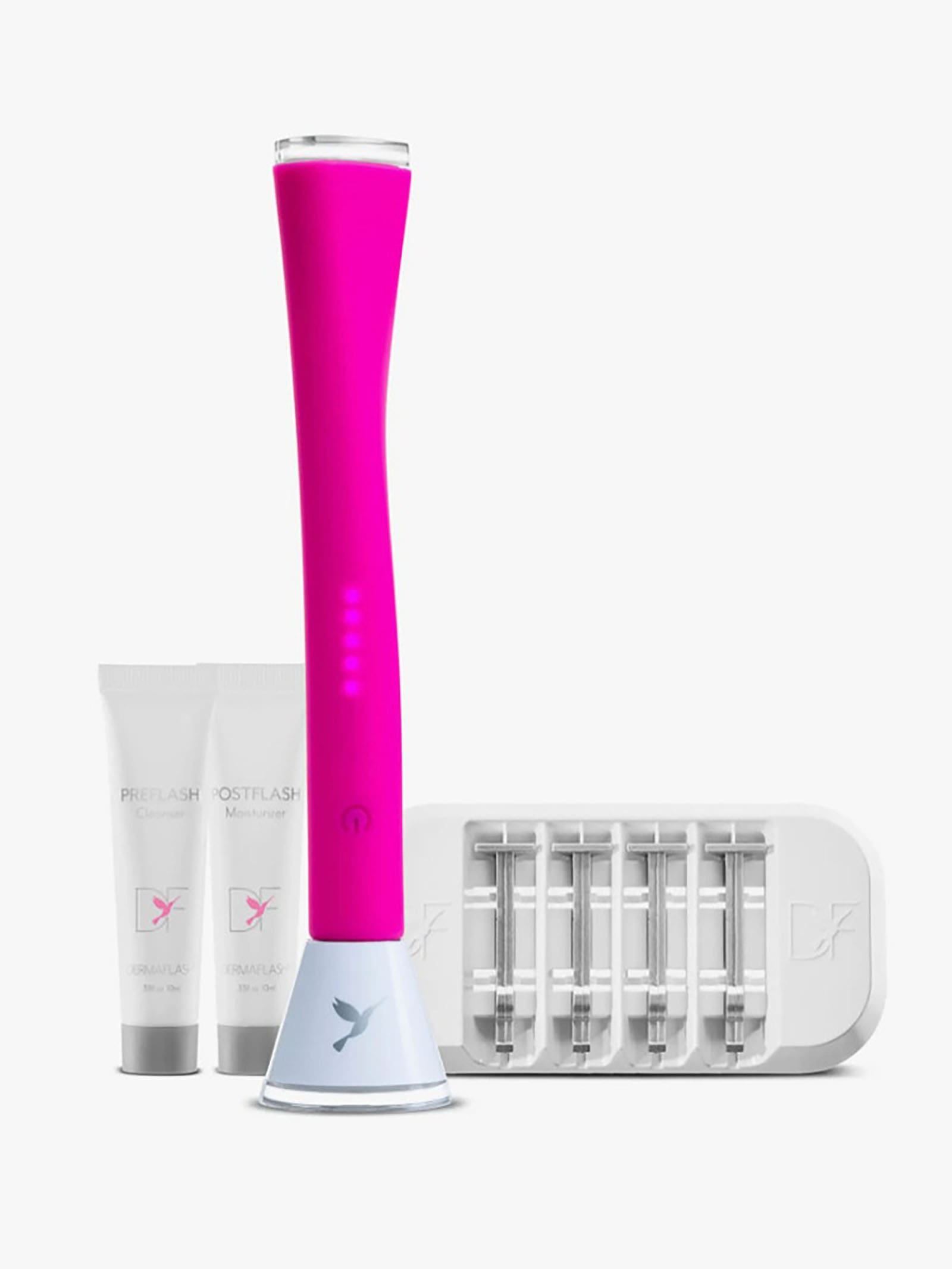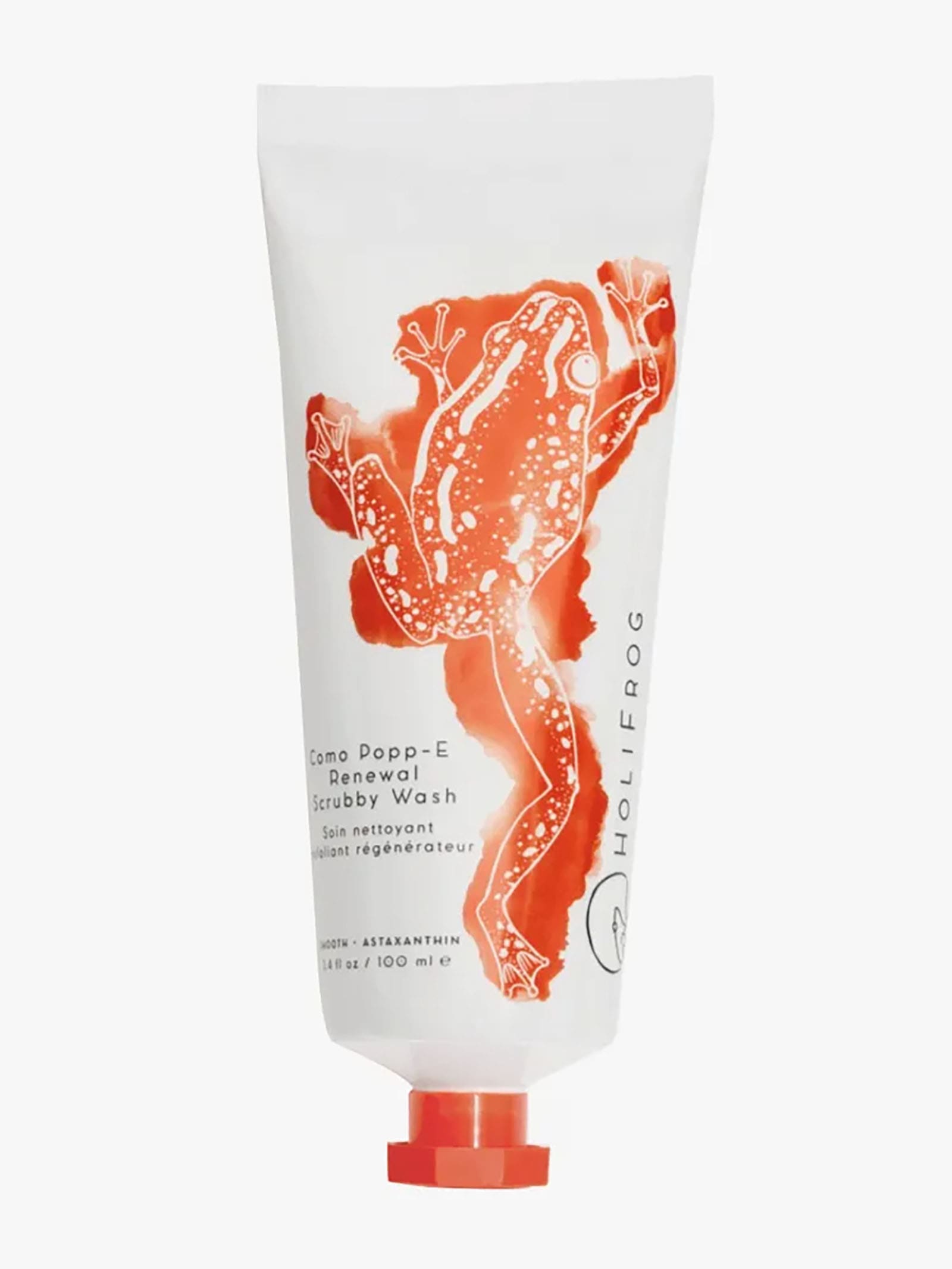Photographed by Mark Nicdao
Learning how to exfoliate your face can be tricky. Especially with so many options these days, everyone is thinking about what it takes to get clear and glowing skin. A recent report from NPD found that 40 percent of regular skincare users in the U.S. are slathering on more products now—and “basic care” picks, such as cleansers, exfoliators, and scrubs, have experienced the most significant jump in demand. On a practical level, this makes sense; debris, oil, and bacteria can pile up on the skin and exfoliating can help unclog congested pores. And sometimes a trip to the spa for a skin-sloughing facial is out of reach for many of us, so incorporating exfoliation into our skincare routines becomes our best bet for keeping our skin healthy.
By design, our skin naturally sheds dead cells in a 28-day cycle. Certain factors (dry, cold air; indoor heating systems; stress) can stall this process, however, so regular, mild exfoliating is crucial to increasing cellular turnover, insists New York–based medical esthetician Jordana Mattioli—especially in the winter months. The myriad ways to effectively break down the top layer of skin can be mystifying, but not all exfoliating products are made the same. Physical exfoliation, the process of manually dislodging dirt and stripping away surface cells with textured bits and grainy particles, was once the gold standard of sloughing. Mechanical exfoliation leverages tech-savvy devices to buff the complexion. Chemical exfoliators, such as alpha- and beta-hydroxy acids, have emerged as arguably some of the safest, and gentlest ways to break down the bonds between skin cells and decongest pores with experts advising patch tests to rule out any irritation before use, and nighttime applications to reduce photosensitivity during the day. But knowing your mandelic acid from your glycolic acid or when to use an exfoliating tool can be overwhelming.
So to break down the different types of exfoliation for you and to help you figure out which skincare products work best for you and your skin, here is an expert-backed, three-step plan. Read this for a safe, effective way to exfoliate and keep skin smooth, calm, and clear all winter long—and beyond.
Benefits of Exfoliation
Other than promoting healthy skin overall, what does incorporating some form of exfoliation into your skincare actually do? New York City-based board-certified dermatologist Michelle Henry, M.D., lists the following major benefits to sloughing away those dead skin cells:
- Reveals brighter skin by removing dead or damaged skin cells
- May stimulate collagen
- Improves overall skin texture and tone and smooth skin
- Allows for active ingredients to penetrate the skin deeper
- Unclogs pores and removes excess dirt, oil, and debris that might cause breakouts for those with oily skin
The upsides to skin exfoliation are just too good to pass up, but there are still a couple of things to take note of before you start scrubbing away.
The Downsides of Over-Exfoliating
Good intentions in skincare can sometimes go awry, especially when it comes to exfoliating. “It’s so easy to overdo it,” says Mattioli of striking the balance between featherlight- and heavy-handed exfoliation, the latter of which can lead to redness, inflammation, and hyperpigmentation, especially among women with Black or brown skin. “As a dermatologist who takes care of skin of color, I see a lot of aggressive exfoliation, and I’m often talking people down off the ledge—urging them to back off their faces,” confirms Carlos A. Charles, M.D., a Manhattan dermatologist and the founder of Derma di Colore, a medical practice that focuses on a range of different skin tones. Henry adds that those with sensitive skin may react negatively towards certain ingredients. So pay attention to your skin and what works best with your skin type when exfoliating to avoid causing more damage.
The Mechanics of Mechanical Exfoliation
If you have a thick layer of dull skin that’s mostly due to dryness and flakes, not acne, Mattioli suggests starting with a mechanical exfoliating tool, which is often more effective than relying on high percentages of acids to break through initial buildup. Mattioli is a fan of Dermaflash Luxe, a device that uses a vibrating blade to ever-so-lightly “scrape away the top layer of skin,” she says; PMD Personal Microderm Classic, which combines spinning microdermabrasion discs that polish your face with “suction to pull out debris from pores,” offers a next step up, Mattioli adds. Los Angeles–based esthetician Shani Darden has long been wary of cleansing tools, many of which, she finds, “can be harsh on skin.” But Darden swears by the Nion Opus Luxe, which has soft, antibacterial silicone bristles that slough away dead skin cells “without causing irritation.”
The Chemical Reaction
Alpha-Hydroxy Acids
Once you’ve removed an initial round of dead skin, acids can further refine the surface and treat your pores, says Connecticut-based dermatologist Mona Gohara, M.D. If you have nonreactive skin, Gohara suggests applying an acid-spiked serum after mechanical exfoliation. Of the overwhelming array of acids on the market, she prefers water-soluble alpha-hydroxy acids (AHAs), which gently loosen the upper layers of skin—producing a peeling action—which helps fade pigmented spots and even out rough or bumpy patches. Henry says those with sensitive skin will want to use mild AHA like lactic acid to get the same exfoliating benefits in a gentler way. Mattioli is partial to mandelic acid, which she considers an “unsung hero” since it has a larger molecular size than other AHAs, so it doesn’t absorb quite as fast (also good thing if you have sensitive skin). Naturium’s new Mandelic Topical Acid 12% pairs this acid with skin-barrier-supporting niacinamide to prevent dryness. For a more intense treatment or for mature complexions, glycolic acid has the smallest molecular weight of all AHAs, so it penetrates the deepest and can build collagen in addition to improving texture and tone. Mattioli advises starting with a low dose, such as Krave Beauty’s Kale-Lalu-yAHA treatment-like toner with 5.25 percent glycolic acid, and increasing the strength gradually. Henry adds this is beneficial to mature skin as these hydrating and brightening ingredients help promote healthy skin all around.
Beta-Hydroxy Acids
Beta-hydroxy acids (BHAs) are oil-soluble and go deeper into the pores than AHAs to clear excess debris and sebum. Mattioli likes azelaic acid, such as The Ordinary’s Azelaic Acid Suspension 10%, as its high molecular-weight effectively kills bacteria while also reducing redness and swelling, making it gentle enough for treating acne and rosacea.
Henry says that oily and acne-prone skin can usually handle stronger chemical exfoliants and be used more frequently. This includes salicylic acid, which Mattioli says can penetrate deep into pores to unblock any congestion, even out skin tone, and smooth the surface. Paula’s Choice 2% BHA Liquid Exfoliant has a devoted following among skin-care junkies. Dallas- and NYC-based aesthetician Joanna Czech, meanwhile, is loyal to the cultish Biologique Recherche P50, which “comes in a variety of strengths,” she says, including a gentle P50W with salicylic acid, “so you can adjust accordingly to your sensitivity and skin conditions.”
If you’ve got combination skin, Henry advises that you go with a blanched approach with a gentle chemical exfoliant and the occasional physical one.
AHA/BHA Blends
A more streamlined chemical exfoliation option is to combine acids in one multitasking formula. Mattioli is partial to Allies of Skin Mandelic Pigmentation Corrector Night Serum, with a buffet of complexion-brightening ingredients (mandelic, lactic, and salicylic acids) and protective antioxidants, making it “such a well-rounded product,” she says. Charles, who recently cofounded 456, a brand that’s specifically designed for skin of color, points to his To Be Clear Exfoliant Mask, with glycolic and salicylic acid, plus probiotics to firm and clear up skin.
Let’s Get Physical
Physical exfoliants can be used once a week, or every other week to maintain skin tone and clarity. Henry recommends wetting your face with lukewarm water before working in a small amount of a physical exfoliant like the Kiehl’s Epidermal Re-Texturizing Microdermabrasion, which she says uses micronized shells to give your skin a gentle exfoliation. To avoid harsh scrubbing, you’ll want to massage your face in circular motions. Then rinse thoroughly with lukewarm water before patting your face dry and following up with a moisturizer.
Mattioli prefers micro-exfoliants—or those with small-size, non-coarse particles—such as the poppy seeds and bamboo powder found in Holifrog’s Como Popp-E Renewal Scrubby Wash, or the brown rice and rosehip seeds in Klur’s Skin Soil, which comes in a dry powder that, when mixed with water, forms a low-friction scrub with just enough grit to disrupt debris without causing damage. Dermologica’s Daily Milkfoliant Exfoliator uses vegan oat powder but is gentle enough for daily use. If you’re sensitive, skip the scrubs altogether, and keep it simple with a washcloth, suggests Czech. “I just rinse with a linen washcloth, which is another great micro-exfoliator,” she elaborates. Move the cloth across your face in small, circular motions to soften any flakes so they can be easily washed away on their own.
All products featured on Vogue are independently selected by our editors. However, when you buy something through our retail links, we may earn an affiliate commission.
This article was originally published on Vogue.com













